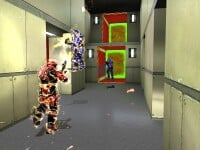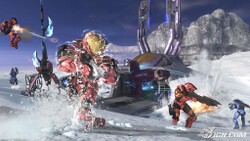Multiplayer
From Halopedia, the Halo wiki
The term 'Multiplayer' generally refers to the ability of most video games allowing more than one person to play the game at the same time in a non-campaign setting. Multiplayer can consist of split-screen, system link, or Xbox Live. In the Halo games, multiplayer has been regarded as a core element to the game's design and a giant part of the success of the Halo franchise.
Halo: Combat Evolved

The multiplayer component of Halo: Combat Evolved for the Xbox was limited to split screen and four Xbox consoles together for System Link play. Five core gametypes are available: Slayer, Oddball, Capture The Flag (CTF), King of the Hill, and Race, as well as a number of stock variants, and the ability for players to create their own gametype variants by tweaking a number of variables, such as player health, weapons on the map, and available vehicles. Players are able to play online via network tunneling programs such as "XBConnect" or "XLink Kai". However, the game tends to freeze and stutter while it works to keep things synchronized; today's internet connection speeds come nowhere close to the 100 megabit connection that the game expects.
Halo PC
The PC version has multiplayer over the internet and can have up to 16 players and custom game types. Players could also play on six maps that did not exist in the console version: Danger Canyon, Death Island, Gephyrophobia, Ice Fields, Infinity, and Timberland. Players are able to host both listen servers and dedicated servers, and have other players join via a server browser provided by GameSpy, as well as by entering the domain name or IP address of a server if it's known, and by a LAN browser. Halo PC multiplay has no stat tracking, set rules, global banlist, or cheat detection past what server administrators provide, making competitive organization not an easy task, and cheaters/griefers are an issue when server administrators are absent.
Halo: Custom Edition
Halo: Custom Edition, a multiplayer-only expansion, implemented a network code, and of course, custom, user-made multiplayer maps created with the Halo Editing Kit. Amongst these maps were a number of Halo 2 ports, such as Zanzibar[1] and Coagulation[2]. Recently, there have been Halo 3 ports in progress, such as The Pit[3]. In addition, there are a vast number of non-canon maps set in Halo universe-inspired locations using only Halo assets, as well as many other maps which can incorporate custom weapons, vehicles, locations, and player characters.
List of Halo: Combat Evolved Gametypes
Halo 2
Multiplayer was completely redesigned for Halo 2. Built around the framework of Xbox LIVE, players now had more options available to play online. Matchmaking allowed players to search for games in a variety of different playlists, such as Team Objective, Team Doubles, or Rumble Pit. Each playlist offers a number of unique gametypes from that list. Players could also create and host their own custom games, and invite other players and friends to join them. The lobby system was also introduced, allowing players in a party to stick together after games to continue playing or be taken to a different lobby.
Putting Microsoft's Trueskill system to use, Bungie employed a ranking system that displayed a level (1-50) based on how well a player played in a particular playlist. Rankings were for individual playlists, and players who would continually win games in a certain playlist would rank up in that playlist. Bungie also split their multiplayer component into two major categories; ranked and unranked. While the ranked playlists offered players a chance to display skill, the unranked playlists were more social, allowing guests, and did not track ranks. Thus, unranked games tended to be more relaxed.
Halo 2 introduced the concept of awarding medals to players for various accomplishments during a match, such as multikills and sprees, as well as kills caused by certain weapons or vehicles, and for completing objectives in objective-based games. Medals are shown on Bungie.net's game viewers, and in the Postgame Carnage Report.
The Race gametype was removed due to a lack of popularity, and three new gametypes were introduced. An offshoot of Oddball called Juggernaut, an offshoot of Capture the Flag called Assault, and a whole new gametype called Territories.
Halo 2 Vista
Halo 2 Vista utilized the Games for Windows LIVE service, but in a much different way than its XBox counterpart. Rank-based Matchmaking was done away with, and, like its predecessor Halo PC, Halo 2 Vista added a server browser and allowed players to join games in progress, as if the player had joined a custom game. Servers ran a mapcycle in the form of a Playlist, where players would congregate in a lobby until the game starts, play the game, then go back to the lobby to review the Postgame Carnage Report and chat with other players until the next round started. LIVE Gold users could filter out servers not matching their interests, and quickly jump right into a game in progress by selecting a "Quick Match" option, by using a Matchmaking option to have the game find a Matchmaking-only server and more players to play with, or by hosting their own listen server.
Halo 2 Vista did not feature Tombstone or Desolation, but instead offered District and Uplift, as well as the [Halo 2 Map Editor, which allowed players to create custom Halo 2 Vista maps.
Since July 27, 2008, the Gold-only limitations were removed, and all LIVE subscribers, regardless of membership level, could use all aspects of Halo 2 Vista multiplayer without restriction. [4]
List of Halo 2 Gametypes
Halo 3
Halo 3 introduced many new features to its multiplayer experience. The most prominent feature was the ability to play the campaign cooperatively online and via system link with 4 players, with the players 2, 3, and 4 taking on the role of the Arbiter and two other Elites (N'tho 'Sraom and Usze 'Taham), instead of 2-player Co-op with a Master Chief or Arbiter clone controlled by the other player.
Custom gametypes were given a whole new level of customization, with settings such as player gravity, and spawn-time specific attributes (e.g. spawnkill protection). Two new core gametypes, VIP and Infection, were added.
Matchmaking was enhanced with many under-the-hood features to help get better player matches and reduced wait time. Two very useful features were added to the pregame and postgame lobbies: game Vetoes to get rid of games nobody wanted to play, and the "Party Up" feature, so groups of people who enjoyed that last game could stick together. The number of medal types to be attained increased drastically, including medals for killing sprees with certain weapons, the Linktacular Medal for getting matched with nothing but Bungie.net members, and the Steaktacular Medal for winning a Slayer game by at least 20 points.
Finally, custom games were enhanced with the addition of Forge, a multiplayer map editor. In Forge, players can switch to and from a Monitor form on the fly to add, move, and remove objects such as weapons, vehicles, spawn points, and scenery props on the map. There is a budget set in each map for optimization purposes; each object in the map (except for netgame flags and spawn points) has a dollar value tied to it, and the map can only have so much in it. When you run out of money, you cannot place any more objects until you delete other objects. A glitch exists, however, that lets players bypass the budget and place as many items on the map as they want.
Multiplayer Beta
The Halo 3 Public Beta consisted of Matchmaking multiplay on a small number of ranked and social playlists, though custom games were eventually broken into via a glitch. The three maps included in the beta were Valhalla, High Ground, and Snowbound. Players were limited to only Mark VI armor permutations, but still could customize colors and emblems.
The Energy Sword and Magnum were absent from Matchmaking games (but found later in the gametype editor when custom games were found) in an attempt to surprise the faithful fans on Halo 3 's release, and the Trip Mine was much more powerful, able to cling to vehicles with a smaller, yet very lethal blast radius.
Ranking, EXP And Skill
The ranking system introduced in Halo 2 was redone in order to balance out Matchmaking even further. The Trueskill system was still present on ranked playlists, but a new "Experience (EXP)" stat was added to player profiles. Whenever a player plays a match entirely and is in a top position or on a winning team, the player gains 1 EXP. Players who enter a playlist, but disconnect or quit early lose 1 EXP for desertion. Players who end up in a losing position or team do not gain or lose EXP. In theory, this helps with player matching and balance by finding players who have been playing the game as much as you have based on their EXP level.
Auto Update 2, live on August 1, 2008, added another player of EXP to even further balance out players. This time, EXP was tracked for each individual playlist, in addition to the player's Trueskill ranks and overall EXP. When in a Matchmaking playlist, players' Trueskill ranks (if a ranked playlist) and playlist-specific EXP are shown. When in a custom game, or viewing a player's details or service record, overall EXP is shown.[5]
List of Halo 3 Gametypes
Create Your Own ReMake
While the Race gametype has been long removed, players can make race gametypes by setting up a VIP variant in which the VIP must reach a checkpoint. When played correctly, this makes gameplay similar to the Rally variant from Halo: Combat Evolved
In Forge, you can make anything from race tracks to bowling alleys using almost anything you can find, giving a variety of game concepts past senseless brutality.
Profiles And Emblems

The profile creator in Halo: Combat Evolved was very basic. Players had the ability to create a unique name, customize their armor color, and change the game controls and settings. Halo PC's settings were more intricate, including options to tweak various sound and video settings, and bind keys or gamepad buttons to each control (as opposed to picking preset control schemes).
With the addition of online multiplayer through Xbox LIVE, the profile creator in Halo 2 was redesigned and altered. Keeping the settings and adjustments from the previous game, Bungie added more color variants to the palette, and the ability for armor to have two colors. In addition, a major change was the addition of Covenant Elite model for players to use, rather than the standard UNSC Spartan model. To identify players better on the battlefield, Bungie included a "multiplayer emblem" in which players could customize the look and color to distinguish themselves. Emblems appeared on the HUD over teammates' heads instead of the plain green arrows in Halo: Combat Evolved.
The updated profile creator in Halo 3 gives players a host of different options to change, tweak and modify their multiplayer avatar. Again, the options from the previous games are included. However, the newest of these options include Armor Permutations for the left and right shoulders, the helmet, and the chest piece. Different armor permutations can be unlocked by gaining achievements, completing the campaign, completing certain levels on certain difficulties, or by finding skulls.
The list of multiplayer emblems is larger than in Halo 2. Subtle differences in the emblem (i.e. hiding the portion of the emblem that uses the secondary color by pressing X) have been made possible. Players can now choose from a number of preset backgrounds as well. In addition, there are three color settings for emblems as well; primary, secondary, and background. Due to the vast amount of female gamers in Halo 2, Bungie added in a gender option which changes the voice of the player when the player is killed. Finally, players may choose a callsign (UNSC Service Tag), consisting of a letter followed by two numbers (e.g. A12, P01) so that players may easily recognize you on the battlefield.
Halo Wars
Halo Wars allows you to play in a variety of multiplayer arenas. You can choose from 3 different commanders from both the UNSC or the Covenant side. You can play either 1v1, 2v2, or 3v3, on either Standard or Deathmatch modes, with all human players or some human players. There is also a form of ranking system, which is very similar to that in Halo 3 except that in Halo Wars it's based on your score in completed matchmaking games meaning you not only get a little bit for a loss but also get more for a convincing victory than for a lucky break.
Trivia
- In Halo: Combat Evolved, players usually start with a Plasma Pistol on Slayer gametypes, or Pistol and Assault Rifle on gametypes with the starting loadout set to "Generic". In Halo 2, players usually start with SMGs, except on the map Tombstone, where players will also start with a Battle Rifle. In Halo 3, players start with Assault Rifles and Magnums.
- In Halo 2, the map Backwash is one of the most underplayed maps. The map was actually taken out of rotation by Bungie because of vast complaints regarding flat-panel TV's. The level will leave traces of ghost images on the screen until the Xbox is fully power-cycled.
- In Halo 2, players didn't need to lead their targets with the Battle Rifle. However, in Halo 3, leading is needed to hit a moving opponent. This is due to the Halo 2 version of the Battle Rifle being a hitscan weapon, whereas the Halo 3 version has actual projectiles being fired.[6]
- In Halo 2 multiplayer or campaign, pressing "down" on the D-Pad causes characters to stand "at ease." Throwing all grenades and holding down the Left Trigger will also produce the same effect. This technique has been used in many machinimas like "Red vs Blue" or "The Codex" to make the characters appear to be in conversation, rather than holding their weapons at the ready. However, only the latter method works on Xbox Live. This was changed in Halo 3; a player must hold Reload, Action, Jump, Crouch, and Down (D-pad) simultaneously for 4 seconds. However, this only works on Local games, not over Xbox Live.
- In Halo 3, the chances of having the same UNSC Service Tag as another player are approximately 1 in 2571.
- In "Halo 3" multiplayer your second weapon is shown on your back or holstered on your thigh (depending on the weapon). If you are operating a vehicle, turret, or missile pod, your main weapon will be displayed on your back.
- In Halo 3, a player's service tag can not be l17 (lower case L and 17) or I17 (upper case I and 17) stating that is reserved for service in the UNSC. It can also never be E43, N64, P52, F46, A55 or A01, due to some of them being acronyms of other companies' consoles (though N35, P53, and W11 are allowed), or 1337 conversions of offensive words, and any service tag ending with 00 is reserved. When a new profile is created, the profile has a small chance of having a reserved/restricted service tag generated.
- In Halo 3, when a guest is playing, their service tag is O00 even if they try and change it through the appearance options.
- In Halo 3 multiplayer, if you are the party leader in a custom game, the "End Game" option in the menu will say, "Choose this option to put an end to the conflict before it ends itself." For all other players, the "Leave Game" option will say: "Choose this option to embrace your cowardice and leave the game prematurely." Attempting to leave a team-based XBOX LIVE match will warn you that "Quitting is discouraged in the UNSC. Do you want to lose EXP as a penalty for desertion?"
- The maximum number of players that can play in all versions of Halo Multiplayer is 16, via System Link, Xbox Live, and Internet.
- In Halo 3, Bungie will offer a "Double EXP Weekend" playlist making it easier for players to level up during weekends.
- In Halo 3, Bungie will offer a "7 on 7 on the 7th" playlist dedicated to getting Achievements based on DLC maps around the 7th of every month. Obviously, this is a throwback to Bungie's favorite number.
References
- ^ http://hce.halomaps.org/index.cfm?fid=1153
- ^ http://hce.halomaps.org/index.cfm?fid=3108
- ^ http://www.modacity.net/forums/showthread.php?t=12501
- ^ http://www.developmag.com/news/30211/Games-for-Windows-Live-now-free-to-developers
- ^ http://www.bungie.net/News/content.aspx?type=topnews&cid=14994
- ^ http://www.bungie.net/News/content.aspx?cid=14347
Related Pages
